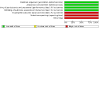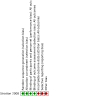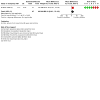Selective oestrogen receptor modulators (SERMs) for endometriosis
- PMID: 33973648
- PMCID: PMC8130989
- DOI: 10.1002/14651858.CD011169.pub2
Selective oestrogen receptor modulators (SERMs) for endometriosis
Abstract
Background: Endometriosis is defined as the presence of endometrial tissue outside the uterine cavity. This chronic and recurring condition occurs in women of reproductive age. It is a common cause of pain or infertility and can cause non-specific symptoms such as lower back pain, dyspareunia (pain during or after intercourse), and dysmenorrhoea (menstrual pain). Endometriosis is an oestrogen-dependent disease. Medical treatment aims to relieve symptoms and shrink lesions by suppressing the normal menstrual cycle. In this review, we consider medication specifically aiming to modulate oestrogen receptors as an alternative method of treatment.
Objectives: To evaluate the effectiveness and safety of selective oestrogen receptor modulators (SERMs) in the management of endometriosis.
Search methods: We searched for trials in the following databases (from their inception to 28 May 2020): Cochrane Gynaecology and Fertility Group Specialised Register, Cochrane Central Register of Studies (CRS Online), MEDLINE, Embase, CINAHL, PsycINFO, and registers of ongoing trials. In addition, we searched all reference lists of included trials, and we contacted experts in the field, in an attempt to locate trials.
Selection criteria: We included randomised controlled trials (RCTs) comparing selective oestrogen receptor modulators (SERMs) with placebo, no treatment, other medical treatment, or surgery for endometriosis.
Data collection and analysis: We used standard methodological procedures recommended by Cochrane. Two review authors independently selected trials for inclusion, assessed risk of bias, and extracted data using data extraction forms. We used risk ratios (RRs) with 95% confidence intervals (CIs) for reporting dichotomous data. Primary review outcomes were relief of pelvic pain and adverse events. Secondary outcomes included quality of life, recurrence rate, and economic and fertility outcomes.
Main results: We included only one RCT, which included 93 women, comparing the SERM raloxifene with placebo in biopsy-proven endometriosis. All women first underwent complete surgical excision of all lesions. Evidence was of very low quality: the main limitation was imprecision - with very sparse data from only one small study, which included only women after surgical treatment. Relief of pelvic pain The included study did not specifically measure the primary outcome of pain relief. Study authors reported that time to return of pelvic pain (defined as two months of pain equal to or more severe than pain at study entry) was more rapid in the raloxifene group (P = 0.03). Adverse events The included study reported adverse events such as pelvic pain, ovarian cyst, headache, migraine, and depression. We are uncertain whether raloxifene improves the incidence of pelvic pain (RR 1.25, 95% CI 0.63 to 2.45), ovarian cysts (RR 1.57, 95% CI 0.55 to 4.43), headache (RR 1.09, 95% CI 0.49 to 2.43), migraine (RR 0.73, 95% CI 0.28 to 1.95), depression (RR 1.96, 95% CI 0.63 to 6.06), or other adverse events (RR 0.08, 95% CI 0.00 to 1.30) (all: 1 study, n = 93; very low-quality evidence). Quality of life The study described a statistically significant difference in mental health quality of life (QoL) by 12 months, in favour of placebo treatment (mean difference 11.1, 95% CI 0.01 to 21.19). Other QoL data did not differ between groups but were not reported in detail. Recurrence rate, fertility, and economic outcomes We are uncertain whether raloxifene improves the recurrence rate of endometriosis, proven by biopsy, when compared to placebo (RR 1.20, 95% CI 0.66 to 2.21; 1 study, n = 93; very low-quality evidence). This suggests that if 28% of women taking placebo have biopsy-proven recurrence of endometriosis, between 19% and 62% of those taking raloxifene will do so. These outcomes are prone to bias, as not all women had an actual second laparoscopy. Recurrence based on symptoms (non-menstrual pain, dysmenorrhoea, or dyspareunia) was described; in these cases, symptoms improved after use of raloxifene as well as after use of placebo. The included study did not report data on economic outcomes. No comparative data were available on pregnancy, as the study included only women who agreed to postpone pregnancy until after the study endpoint; the few pregnancies that did occur were uneventful but were regarded as an adverse event. AUTHORS' CONCLUSIONS: Based on a single, small RCT and incomplete data, we are uncertain of the effects of SERMs on pain relief in surgically treated patients with endometriosis. The included study was stopped prematurely because of higher pain scores among women who took SERMs when compared to scores among those receiving placebo. Further research is needed to fully evaluate the role of SERMs in endometriosis.
Copyright © 2021 The Cochrane Collaboration. Published by John Wiley & Sons, Ltd.
Conflict of interest statement
MvH: no commercial interests to disclose.
SM: no commercial interests to disclose.
YC: none known.
QW: none known.
AZ: none known.
Figures






Update of
- doi: 10.1002/14651858.CD011169
References
References to studies included in this review
Stratton 2008 {published data only}
References to studies excluded from this review
Barra 2019 {published data only}
-
- Barra F, Evangelisti G, Tantari M, Ferrero S. Effect of ospemifene on patients with symptomatic genitourinary syndrome of menopause affected by deep endometriosis. BJOG: an International Journal of Obstetrics and Gynaecology. 2019;Conference: 2019 World Congress of the Royal College of Obstretricians and Gynaecologists, RCOG 2019. United Kingdom(126 (Suppl 2)):188.
Harada 2018 {published data only}
Li 1999 {published data only}
-
- Li J, Zheng J, Wang D. Clinical observation on treatment of endometriosis by tonifying qi and promoting blood circulation to remove stasis and purgation principle. Zhong guo Zhong Xi Yi Jie He Za Zhi 1999;19(9):533-5. - PubMed
Parker 2006 {published data only}
-
- Parker JD, Leondires M, Sinaii N, Premkumar A, Nieman LK, Stratton P. Persistence of dysmenorrhea and nonmenstrual pain after optimal endometriosis surgery may indicate adenomyosis. Fertility and Sterility 2006;86(3):711-5. - PubMed
Additional references
Atkins 2004
Becker 2017
Bianconi 2007
-
- Bianconi L, Hummelshoj L, Coccia ME, Vigano P, Vittori G, Veit J, et al. Recognizing endometriosis as a social disease: the European Union-encouraged Italian Senate approach. Fertility and Sterility 2007;88(5):1285-7. - PubMed
Brosens 1993
-
- Brosens I, Donnez J, Benagiano G. Improving the classification of endometriosis. Human Reproduction 1993;8:1792-5. - PubMed
Brown 2010
Brown 2012
Chen 2020
Delmas 1997
-
- Delmas PD, Bjarnason NH, Mitlak BH, Ravoux AC, Shah AS, Huster WJ, et al. Effects of raloxifene on bone mineral density, serum cholesterol concentrations, and uterine endometrium in postmenopausal women. New England Journal of Medicine 1997;337:1641-7. - PubMed
Dunselman 2014
-
- Dunselman GAJ, Vermeulen N, Becker C, Calhaz-Jorge C, D’Hooghe T, et al. ESHRE guideline: management of women with endometriosis. Human Reproduction 2014;29(3):400-12. - PubMed
Egger 1997
Eng ‐Wong 2004
-
- Eng-Wong J, Zujewski JA. Raloxifene and its role in breast cancer prevention. Expert Review of Anticancer Therapy 2004;4:523–32. - PubMed
ESHRE Guideline 2014
Eskenazi and Warner 1997
Francucci 2005
-
- Francucci CM, Romagni P, Boscaro M. Raloxifene: bone and cardiovascular effects. Journal of Endocrinological Investigation 2005;28(10 Suppl):85-90. - PubMed
GRADEpro GDT 2014 [Computer program]
-
- GRADE Working Group, McMaster University GRADEpro GDT. Version accessed before November 2016. Hamilton (ON): GRADE Working Group, McMaster University, 2014.
Guo 2018
Higgins 2011
-
- Higgins JP, Green S (editors). Cochrane Handbook for Systematic Reviews of Interventions Version 5.1.0 (updated March 2011). The Cochrane Collaboration, 2011. Available from handbook.cochrane.org.
Jones 2002
-
- Jones GL, Kennedy SH, Jenkinson C. Health-related quality of life measurement in women with common benign gynecologic conditions: a systematic review. American Journal of Obstetrics and Gynecology 2002;187:501–11. - PubMed
Kondo 2011
Marques 2004
-
- Marques A, Bahamondes L, Aldrighi JM, Petta CA. Quality of life in Brazilian women with endometriosis assessed through a medical outcome questionnaire. Journal of Reproductive Medicine 2004;49:115–20. - PubMed
Maximov 2013
Meuleman 2009
Moher 2009
Parkerson 1990
-
- Parkerson GR Jr, Broadhead WE, Tse CK. The Duke Health Profile: a 17-item measure of health and dysfunction. Medical Care 1990;28(11):1056-72. [PMID: doi: 10.1097/00005650-199011000-00007.The Duke Health Profile.] - PubMed
Rafique 2017
RCOG 2006
-
- Royal College of Obstetricians and Gynaecologists (RCOG). The investigation and management of endometriosis. London (UK): Royal College of Obstetricians and Gynaecologists (RCOG) 2006;24:1-14.
Review Manager 2014 [Computer program]
-
- Nordic Cochrane Centre, The Cochrane Collaboration Review Manager 5 (RevMan5). Version 5.3. Copenhagen: Nordic Cochrane Centre, The Cochrane Collaboration, 2014.
Scott 1990
-
- Scott JA, da Camara CC, Early JE. Raloxifene: a selective estrogen receptor modulator. American Family Physician 1990;60:1131-9. - PubMed
Silfen 1999
-
- Silfen SL, Ciaccia AV, Bryant HU. Selective estrogen receptor modulators: tissue selectivity and differential uterine effects. Climacteric 1999;2:268–83. - PubMed
Simsa 2007
-
- Simsa P, Mihalyi A, Kyama CM, Mwenda JM, Fülöp V, D'Hooghe TM. Selective estrogen-receptor modulators and aromatase inhibitors: promising new medical therapies for endometriosis? Women's Health 2007;3(5):617-28. - PubMed
Thiebaud 2001
-
- Thiebaud D, Secrest RJ. Selective estrogen receptor modulators: mechanism of action and clinical experience. Focus on raloxifene. Reproduction Fertility and Development 2001;13:331–6. - PubMed
Vercellini 1993
-
- Vercellini P, Trespidi L, Colombo A, Vendola N, Marchini M, Crosignani PG. A gonadotropin-releasing hormone agonist versus a low-dose oral contraceptive for pelvic pain associated with endometriosis. Fertility and Sterility 1993;60(1):75-9. [PMID: ] - PubMed
Publication types
MeSH terms
Substances
LinkOut - more resources
Full Text Sources
Other Literature Sources
Medical
